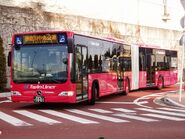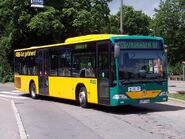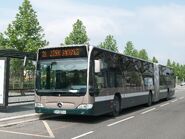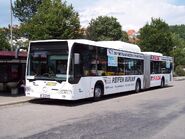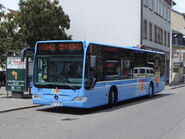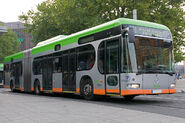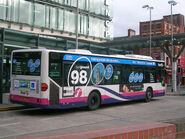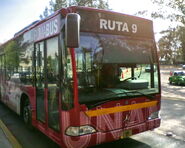| Mercedes-Benz O530 Citaro | |
|---|---|
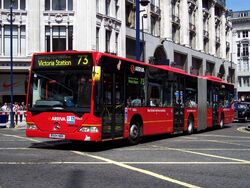 Articulated Citaro G in London | |
| Manufacturer | Mercedes-Benz |
| Operator(s) | Various across Europe |
| Specifications | |
| Floor type | Low floor |
| Doors |
2, 3 or 4 door (Bendy buses) 1, 2 or 3 door (Single decker bus) |
| Engine(s) | Mercedes-Benz |
| Options | Various customer options |
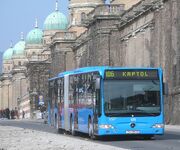
Citaro G (version II - face-lifted) in Zagreb, Croatia
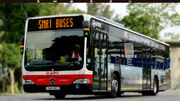
Citaro in Singapore, owned by SMRT Buses
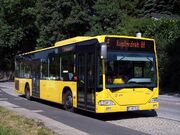
Citaro in Essen, Germany
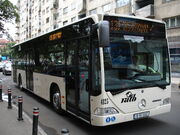
Citaro in Bucharest

Interior (standard urban model)
The Mercedes-Benz Citaro (or O530) is the current Mercedes-Benz/EvoBus mainstream single-decker bus intended for public transport, introduced in 1997 and replaced the Mercedes-Benz O405/O405N series. Manufactured in Mannheim (Germany), Ligny-en-Barrois (France) and Sámano (Spain), it features a low floor for easy access.
Models[]
Urban model[]
The standard urban model is available in a number of versions:
- standard 12m twin-axle
- 10.5m twin-axle (Citaro K)
- 15m tri-axle (Citaro L)
- 18m articulated (Citaro G)
- 20m four-axle articulated (Citaro GL "CapaCity")
- 12m twin-axle "low entry" (Citaro LE)
Suburban/interurban model[]
A series of suburban/interurban versions is also produced, with all seats fitted on platforms:
- 12m twin-axle (Citaro Ü)
- 13m twin-axle (Citaro MÜ)
- 15m tri-axle (Citaro LÜ)
- 18m articulated (Citaro GÜ)
- 12m twin-axle "low entry" (Citaro LE Ü)
- 13m twin-axle "low entry" (Citaro LE MÜ)
Specifications[]
Operators are able to choose between two different front stylings: the standard design features an angled destination display and is primarily marketed for urban buses, while a version with a one-piece windscreen covering the destination display also is available and is primarily intended for interurban use. However, all models are available with either version.
Other customizations include the number and type of doors as well as the internal layout. Two types of seats are offered as part of the standard range, again with a basic model for urban use and an enhanced version for longer-distance routes, although both also are available on all models.
Aside from the usual diesel engines, the Citaro is also available with a powerful Euro IV natural gas engine (model M 447 hLAG) rated at 185 kW (252 PS) or 240 kW (326 PS) - the latter rating used mainly for interurban and articulated buses or standard-length city buses operating in areas with a hilly topography. These engines are also optionally available with Enhanced Environmentally-friendly Vehicle (EEV) certification, meaning that their emission levels are lower than even the most stringent European Union emissions standards.
In 2005, Mercedes-Benz/EvoBus launched a new version of the Citaro to coincide with the introduction of Euro IV-, Euro V- and EEV-compliant engines. Apart from minor technical alternations, mainly to accommodate the new generation of engines, the external design received a facelift to give the buses a less angular look, with internal panelling altered accordingly. Production of the old model ceased by autumn 2006. The Citaro LE and Citaro LE Ü models, which were introduced at the same time, were never produced to the old design.
Non-standard bodies[]
As a one-off, German operators üstra of Hanover and LVB of Leipzig took delivery of a batch of Citaros bodied to a special design by James Irvine for the 2000 World Exposition. Leipzig's vehicles were lent to Hanover for the duration of the exhibition, but subsequently returned to normal service in their home city. All other Citaros bodied by Mercedes-Benz were to standard designs, however a number of chassis were bodied by independent manufacturers, most notably Hess of Switzerland. However, the Citaro has more recently only been sold as a complete product.
In 2007 the workshops of the Szeged (Hungary) bus operator SZKT converted a regular Citaro to a trolleybus. As of April 2010 5 such buses are already serving as a trolley and more examples are in preparation in the near future.[1]
In 2009, the Centre of Ambulance Services in Dubai took delivery of three Citaros, which had been modified to become the world's largest ambulances.
Hydrogen fuel cell version[]
Even though the usual Citaro models are powered by diesel or natural gas, there is also a hydrogen fuel cell-powered version, designated Citaro BZ or O530BZ. About 35 of these buses have been in service in a variety of different world cities in order to test the feasibility of hydrogen fuel cells in different operating circumstances and different conditions, especially weather conditions.
Hybrid electric version[]
The Mercedes-Benz Citaro G BlueTec Hybrid is a series-hybrid articulated bus with a compact 450 kg, 4-cylinder, 4.8 litre, 160 kW, Euro 4 OM-924LA diesel engine providing power for a roof-mounted 19.4 kWh lithium-ion battery pack, and four 80 kW electric wheel hub motors located on the centre and rear axles. (Contrast a conventional bus diesel engine: 6-cylinder, 12 litre, 1,000 kg.) The battery pack is also charged by regenerative braking (recuperation). The manufacturer anticipates fuel consumption 20% to 30% lower than conventional diesel Citaros. Field trials with a public transport operator are planned for 2009. [2] [3] [4]
London fires[]
- Main article: Articulated buses in London
When Transport for London bought articulated Citaros in 2003 and 2004, four buses caught fire, although there were no casualties involved. In fact, one was burnt on its delivery journey, for unexplained reasons. Mercedes-Benz did, however, address the problem, though the buses were withdrawn for some time that saw the brief return of the just-retired Routemasters. Unfortunately, these buses were said to have marred the reputation of articulated buses in the United Kingdom, and some Londoners nicknamed them "Chariots of Fire".[5]
Latin American Citaros[]
In Latin America, Citaros are not present in large quantities in public transport systems. Only Mexico has 14 Spanish-built Citaros for the BRT Internal System of UNAM.
It is rumored that several public transport enterprises have plans to acquire Citaros in Mexico.
Gallery[]
References[]
- ↑ YouTube: Mercedes-Benz Citaro trolley in Szeged. Retrieved on 31 October 2007.
- ↑ "Mercedes-Benz Citaro G Bluetec Hybrid Bus Given 2008 DEKRA Environmental Award". Green Car Congress (2008-01-31). Retrieved on 2009-02-23.
- ↑ Michael Graham Richard (2008-01-31). "Citaro Hybrid Bus Wins 2008 DEKRA Environmental Award". Treehugger. Retrieved on 2009-02-23.
- ↑ "The 2008 DEKRA environmental award - The Citaro G Blue Tec Hybrid bus". Mercedes-Benz - Omnibus News (2008). Retrieved on 2009-02-23.
- ↑ The London Bus Page: Chariots Of Fire Taken Off The Road. 25 March 2004; retrieved on 31 October 2007.
See also[]
External links[]
- EvoBus
- Mercedes-Benz/EvoBus Citaro page
- Mercedes-Benz/EvoBus Citaro G page
- Mercedes Citaro first version in Bucharest
- Mercedes Citaro new 2007 version in Bucharest
- Paumgarten, Nick (2008-05-26). "Ich Bin Ein M4", New Yorker. Retrieved on 2008-05-24.
Hydrogen[]
- Official website of the Fuel Cell Bus Club
- Official website of Icelandic New Energy with information including details of ECTOS
- Section of the Western Australia Department of Planning and Infrastructure's website with details of the Perth Citaro BZ trial
| This page uses some content from Wikipedia. The original article was at Mercedes-Benz Citaro. The list of authors can be seen in the page history. As with Tractor & Construction Plant Wiki, the text of Wikipedia is available under the Creative Commons by Attribution License and/or GNU Free Documentation License. Please check page history for when the original article was copied to Wikia |
Template:Mercedes-Benx vehicles
| |||||||||||||||||||||||||||||||||||||||||||||||||||||||||||||||||||||||||

